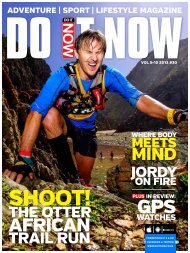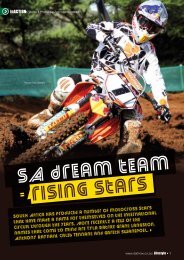Download PDF here - DO IT NOW Magazine
Download PDF here - DO IT NOW Magazine
Download PDF here - DO IT NOW Magazine
You also want an ePaper? Increase the reach of your titles
YUMPU automatically turns print PDFs into web optimized ePapers that Google loves.
FROM TOP TO BOTTOM:<br />
1. Between Camp 1 and Camp 2 - passing a<br />
crevasse - by Sean Disney 2. Climbing in the<br />
Yellow Band on summit day - by Sonam 3. The<br />
team and sherpas at Camp 2 after summiting<br />
- by Sonam 4. A crow’s nest of old ropes as<br />
seen while climbing in the Yellow Band on<br />
summit day - by Sonam 5. View from Camp 2<br />
- by Ben Swart 6. Climbing in the icefall -<br />
by Sonam 7. Lakpa sherpa at the summit<br />
- by Elsie Bezuidenhout<br />
14 • <strong>DO</strong> <strong>IT</strong> <strong>NOW</strong> <strong>Magazine</strong> | January 2013<br />
Scaling mountains such as Cho Oyu is a<br />
team business and materially influenced<br />
by expedition leadership. My summiting<br />
and the team’s success is a function of<br />
enjoying the benefits of a highly experienced<br />
expedition leader and an excellent team of<br />
Nepalese sherpas. These little-big people<br />
are giants at ferrying enormous loads of gear<br />
and material up the mountains, and just as<br />
importantly they attach climbing ropes in the<br />
most inaccessible places ahead of climbers.<br />
Homage is paid to Sean, the quintessential<br />
expedition leader. He led from the front,<br />
pushed from the back, and walked alongside<br />
us. The leader also has to make critical<br />
decisions about safety, climbing ‘rotations’<br />
(climb high, sleep slow), acclimatisation<br />
processes (the human body can adapt over<br />
time to high altitude to allow it to partially<br />
compensate for the lack of oxygen), and<br />
assessing weather patterns. Sean constantly<br />
monitored weather forecasts to programme<br />
the final rotation for the summit attempt. His<br />
accurate weather decisions were crucial to<br />
our success. On some of the rotations we<br />
faced blizzards and winds of up to 80 km/h,<br />
but crucially on summit day we enjoyed the<br />
most spectacular clear and calm day.<br />
The expedition commenced in Kathmandu.<br />
From t<strong>here</strong> we travelled in an entourage of<br />
Land Cruisers across the Nepal/Tibetan<br />
border to Base Camp (BC). At this point<br />
two tonnes of equipment and food were<br />
loaded onto yaks (a sort of long-haired<br />
ox that inhabits the Himalayan area), with<br />
the sherpas in charge, and transported to<br />
Advanced Base Camp (ABC). The entire<br />
extended team hiked the 23 km to ABC<br />
over two days. During this time our gear<br />
was tested when we were confronted by a<br />
massive blizzard.<br />
ABC was located at 5,700 m (just 100 m<br />
lower than the summit of Kilimanjaro). The<br />
selected ABC area is a sea of huge boulders<br />
randomly scattered and surrounded by<br />
peaks covered in snow and ice that tower<br />
7,000 m into the air. Moments of high<br />
visibility rendered an awe inspiring view<br />
of Mount Cho Oyu to the east. We spent<br />
most of our six-week expedition <strong>here</strong> at<br />
ABC; it was our ‘recovery zone’ and w<strong>here</strong><br />
our bodies adapted to the altitude and<br />
rigours of mountain climbing. From ABC<br />
we ventured through a three-kilometre<br />
boulder-strewn valley to reach the foot of a<br />
monster 400 m vertical scree slope (scree<br />
is a steep slope with loose rock and debris)<br />
before reaching Camp 1 at 6,400 m on a<br />
snow-covered ridge. We repeated this<br />
to and fro hike four times as part of our<br />
acclimatisation process.







